(Solved) Essay on Mental Health Nursing
VerifiedAdded on 2021/05/30
|8
|2941
|111
AI Summary
Contribute Materials
Your contribution can guide someone’s learning journey. Share your
documents today.
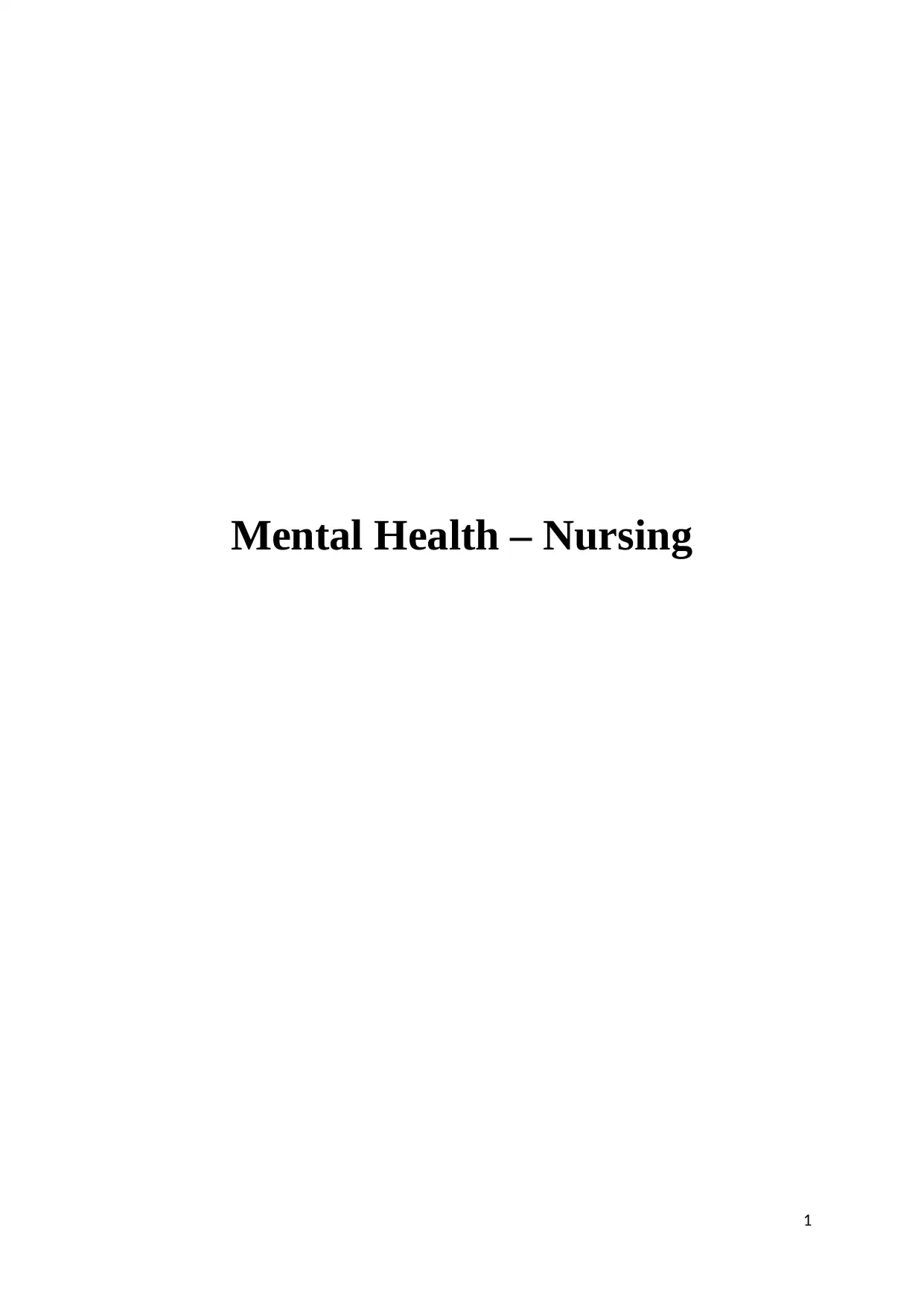
Mental Health – Nursing
1
1
Secure Best Marks with AI Grader
Need help grading? Try our AI Grader for instant feedback on your assignments.
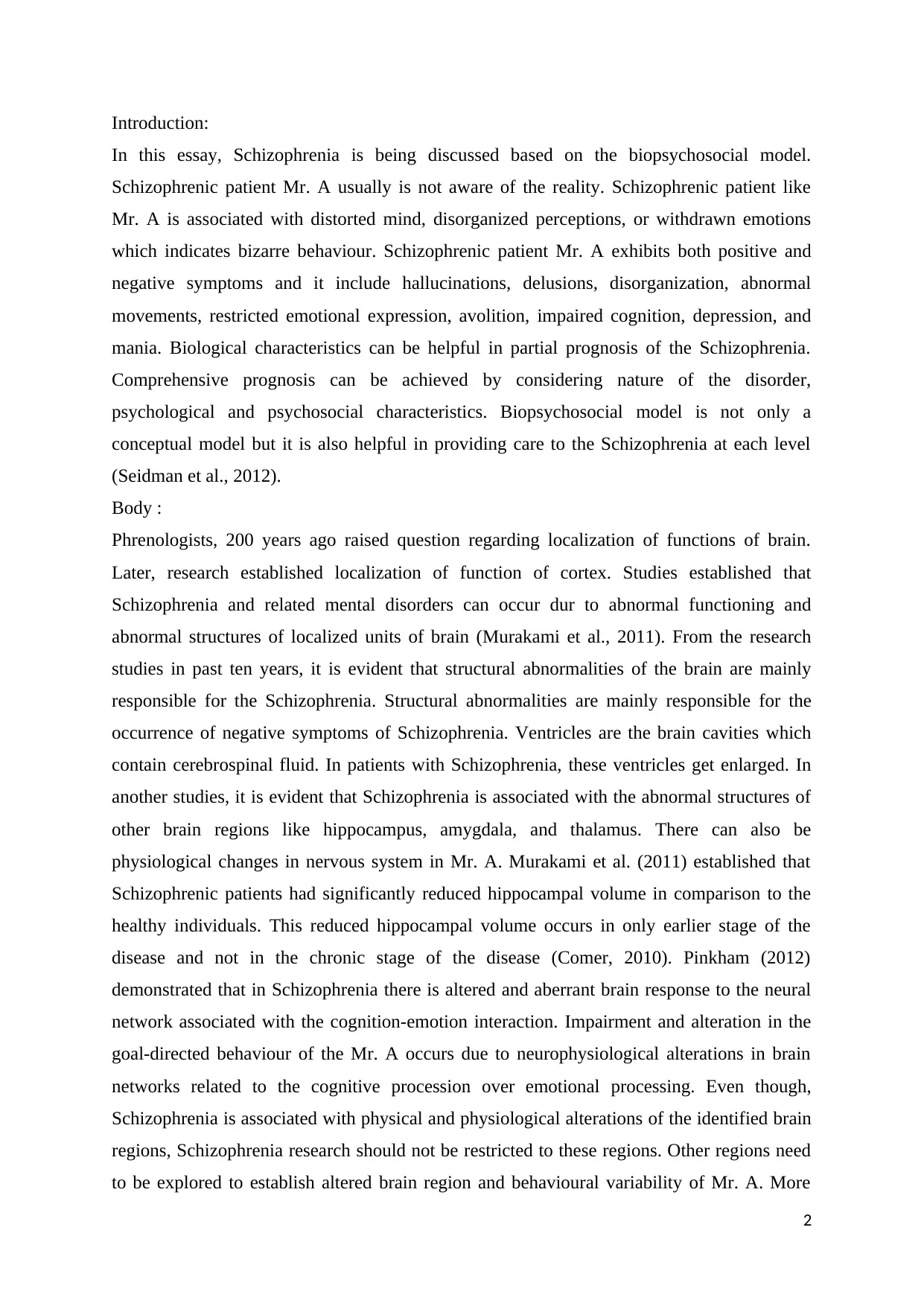
Introduction:
In this essay, Schizophrenia is being discussed based on the biopsychosocial model.
Schizophrenic patient Mr. A usually is not aware of the reality. Schizophrenic patient like
Mr. A is associated with distorted mind, disorganized perceptions, or withdrawn emotions
which indicates bizarre behaviour. Schizophrenic patient Mr. A exhibits both positive and
negative symptoms and it include hallucinations, delusions, disorganization, abnormal
movements, restricted emotional expression, avolition, impaired cognition, depression, and
mania. Biological characteristics can be helpful in partial prognosis of the Schizophrenia.
Comprehensive prognosis can be achieved by considering nature of the disorder,
psychological and psychosocial characteristics. Biopsychosocial model is not only a
conceptual model but it is also helpful in providing care to the Schizophrenia at each level
(Seidman et al., 2012).
Body :
Phrenologists, 200 years ago raised question regarding localization of functions of brain.
Later, research established localization of function of cortex. Studies established that
Schizophrenia and related mental disorders can occur dur to abnormal functioning and
abnormal structures of localized units of brain (Murakami et al., 2011). From the research
studies in past ten years, it is evident that structural abnormalities of the brain are mainly
responsible for the Schizophrenia. Structural abnormalities are mainly responsible for the
occurrence of negative symptoms of Schizophrenia. Ventricles are the brain cavities which
contain cerebrospinal fluid. In patients with Schizophrenia, these ventricles get enlarged. In
another studies, it is evident that Schizophrenia is associated with the abnormal structures of
other brain regions like hippocampus, amygdala, and thalamus. There can also be
physiological changes in nervous system in Mr. A. Murakami et al. (2011) established that
Schizophrenic patients had significantly reduced hippocampal volume in comparison to the
healthy individuals. This reduced hippocampal volume occurs in only earlier stage of the
disease and not in the chronic stage of the disease (Comer, 2010). Pinkham (2012)
demonstrated that in Schizophrenia there is altered and aberrant brain response to the neural
network associated with the cognition-emotion interaction. Impairment and alteration in the
goal-directed behaviour of the Mr. A occurs due to neurophysiological alterations in brain
networks related to the cognitive procession over emotional processing. Even though,
Schizophrenia is associated with physical and physiological alterations of the identified brain
regions, Schizophrenia research should not be restricted to these regions. Other regions need
to be explored to establish altered brain region and behavioural variability of Mr. A. More
2
In this essay, Schizophrenia is being discussed based on the biopsychosocial model.
Schizophrenic patient Mr. A usually is not aware of the reality. Schizophrenic patient like
Mr. A is associated with distorted mind, disorganized perceptions, or withdrawn emotions
which indicates bizarre behaviour. Schizophrenic patient Mr. A exhibits both positive and
negative symptoms and it include hallucinations, delusions, disorganization, abnormal
movements, restricted emotional expression, avolition, impaired cognition, depression, and
mania. Biological characteristics can be helpful in partial prognosis of the Schizophrenia.
Comprehensive prognosis can be achieved by considering nature of the disorder,
psychological and psychosocial characteristics. Biopsychosocial model is not only a
conceptual model but it is also helpful in providing care to the Schizophrenia at each level
(Seidman et al., 2012).
Body :
Phrenologists, 200 years ago raised question regarding localization of functions of brain.
Later, research established localization of function of cortex. Studies established that
Schizophrenia and related mental disorders can occur dur to abnormal functioning and
abnormal structures of localized units of brain (Murakami et al., 2011). From the research
studies in past ten years, it is evident that structural abnormalities of the brain are mainly
responsible for the Schizophrenia. Structural abnormalities are mainly responsible for the
occurrence of negative symptoms of Schizophrenia. Ventricles are the brain cavities which
contain cerebrospinal fluid. In patients with Schizophrenia, these ventricles get enlarged. In
another studies, it is evident that Schizophrenia is associated with the abnormal structures of
other brain regions like hippocampus, amygdala, and thalamus. There can also be
physiological changes in nervous system in Mr. A. Murakami et al. (2011) established that
Schizophrenic patients had significantly reduced hippocampal volume in comparison to the
healthy individuals. This reduced hippocampal volume occurs in only earlier stage of the
disease and not in the chronic stage of the disease (Comer, 2010). Pinkham (2012)
demonstrated that in Schizophrenia there is altered and aberrant brain response to the neural
network associated with the cognition-emotion interaction. Impairment and alteration in the
goal-directed behaviour of the Mr. A occurs due to neurophysiological alterations in brain
networks related to the cognitive procession over emotional processing. Even though,
Schizophrenia is associated with physical and physiological alterations of the identified brain
regions, Schizophrenia research should not be restricted to these regions. Other regions need
to be explored to establish altered brain region and behavioural variability of Mr. A. More
2
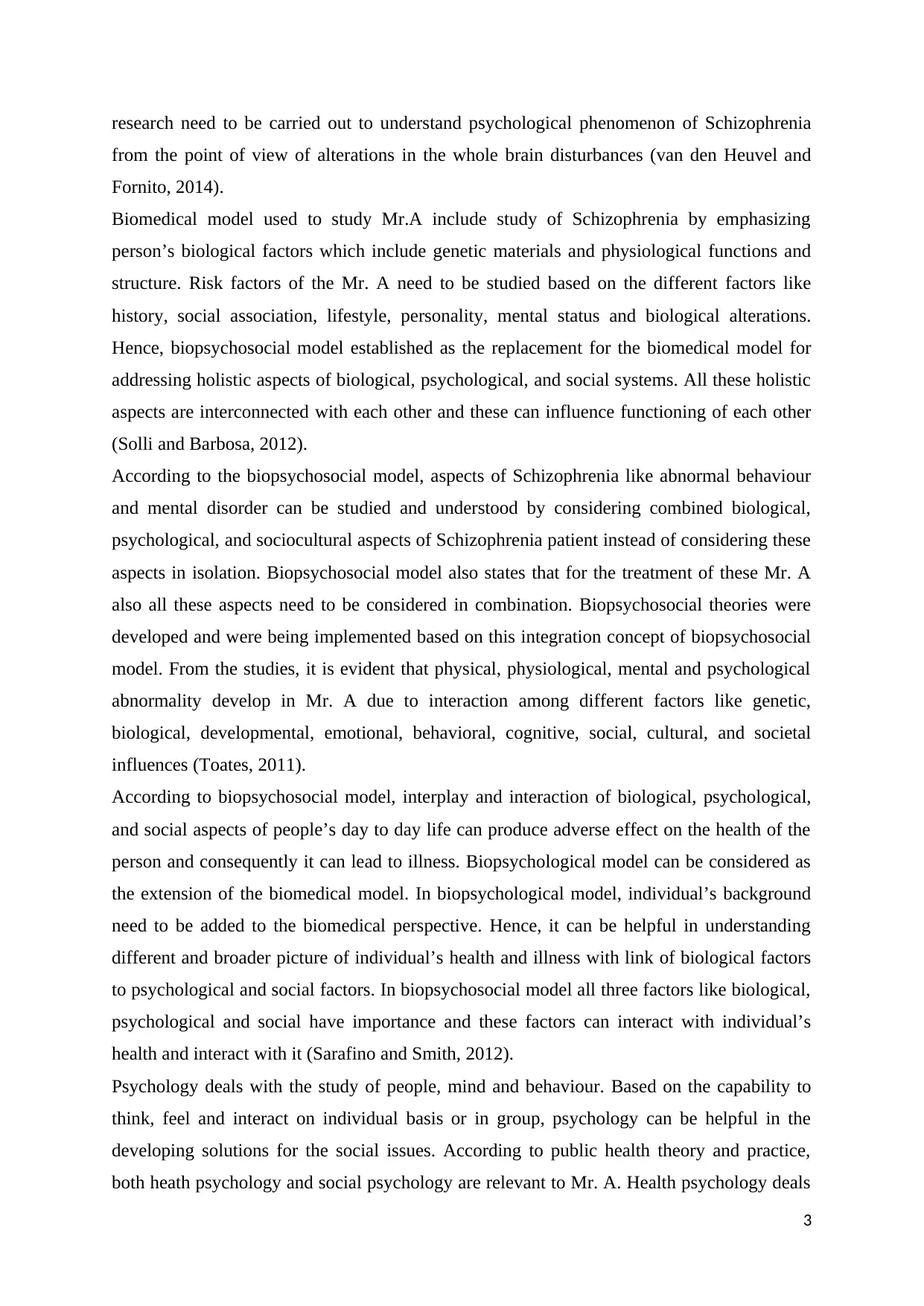
research need to be carried out to understand psychological phenomenon of Schizophrenia
from the point of view of alterations in the whole brain disturbances (van den Heuvel and
Fornito, 2014).
Biomedical model used to study Mr.A include study of Schizophrenia by emphasizing
person’s biological factors which include genetic materials and physiological functions and
structure. Risk factors of the Mr. A need to be studied based on the different factors like
history, social association, lifestyle, personality, mental status and biological alterations.
Hence, biopsychosocial model established as the replacement for the biomedical model for
addressing holistic aspects of biological, psychological, and social systems. All these holistic
aspects are interconnected with each other and these can influence functioning of each other
(Solli and Barbosa, 2012).
According to the biopsychosocial model, aspects of Schizophrenia like abnormal behaviour
and mental disorder can be studied and understood by considering combined biological,
psychological, and sociocultural aspects of Schizophrenia patient instead of considering these
aspects in isolation. Biopsychosocial model also states that for the treatment of these Mr. A
also all these aspects need to be considered in combination. Biopsychosocial theories were
developed and were being implemented based on this integration concept of biopsychosocial
model. From the studies, it is evident that physical, physiological, mental and psychological
abnormality develop in Mr. A due to interaction among different factors like genetic,
biological, developmental, emotional, behavioral, cognitive, social, cultural, and societal
influences (Toates, 2011).
According to biopsychosocial model, interplay and interaction of biological, psychological,
and social aspects of people’s day to day life can produce adverse effect on the health of the
person and consequently it can lead to illness. Biopsychological model can be considered as
the extension of the biomedical model. In biopsychological model, individual’s background
need to be added to the biomedical perspective. Hence, it can be helpful in understanding
different and broader picture of individual’s health and illness with link of biological factors
to psychological and social factors. In biopsychosocial model all three factors like biological,
psychological and social have importance and these factors can interact with individual’s
health and interact with it (Sarafino and Smith, 2012).
Psychology deals with the study of people, mind and behaviour. Based on the capability to
think, feel and interact on individual basis or in group, psychology can be helpful in the
developing solutions for the social issues. According to public health theory and practice,
both heath psychology and social psychology are relevant to Mr. A. Health psychology deals
3
from the point of view of alterations in the whole brain disturbances (van den Heuvel and
Fornito, 2014).
Biomedical model used to study Mr.A include study of Schizophrenia by emphasizing
person’s biological factors which include genetic materials and physiological functions and
structure. Risk factors of the Mr. A need to be studied based on the different factors like
history, social association, lifestyle, personality, mental status and biological alterations.
Hence, biopsychosocial model established as the replacement for the biomedical model for
addressing holistic aspects of biological, psychological, and social systems. All these holistic
aspects are interconnected with each other and these can influence functioning of each other
(Solli and Barbosa, 2012).
According to the biopsychosocial model, aspects of Schizophrenia like abnormal behaviour
and mental disorder can be studied and understood by considering combined biological,
psychological, and sociocultural aspects of Schizophrenia patient instead of considering these
aspects in isolation. Biopsychosocial model also states that for the treatment of these Mr. A
also all these aspects need to be considered in combination. Biopsychosocial theories were
developed and were being implemented based on this integration concept of biopsychosocial
model. From the studies, it is evident that physical, physiological, mental and psychological
abnormality develop in Mr. A due to interaction among different factors like genetic,
biological, developmental, emotional, behavioral, cognitive, social, cultural, and societal
influences (Toates, 2011).
According to biopsychosocial model, interplay and interaction of biological, psychological,
and social aspects of people’s day to day life can produce adverse effect on the health of the
person and consequently it can lead to illness. Biopsychological model can be considered as
the extension of the biomedical model. In biopsychological model, individual’s background
need to be added to the biomedical perspective. Hence, it can be helpful in understanding
different and broader picture of individual’s health and illness with link of biological factors
to psychological and social factors. In biopsychosocial model all three factors like biological,
psychological and social have importance and these factors can interact with individual’s
health and interact with it (Sarafino and Smith, 2012).
Psychology deals with the study of people, mind and behaviour. Based on the capability to
think, feel and interact on individual basis or in group, psychology can be helpful in the
developing solutions for the social issues. According to public health theory and practice,
both heath psychology and social psychology are relevant to Mr. A. Health psychology deals
3
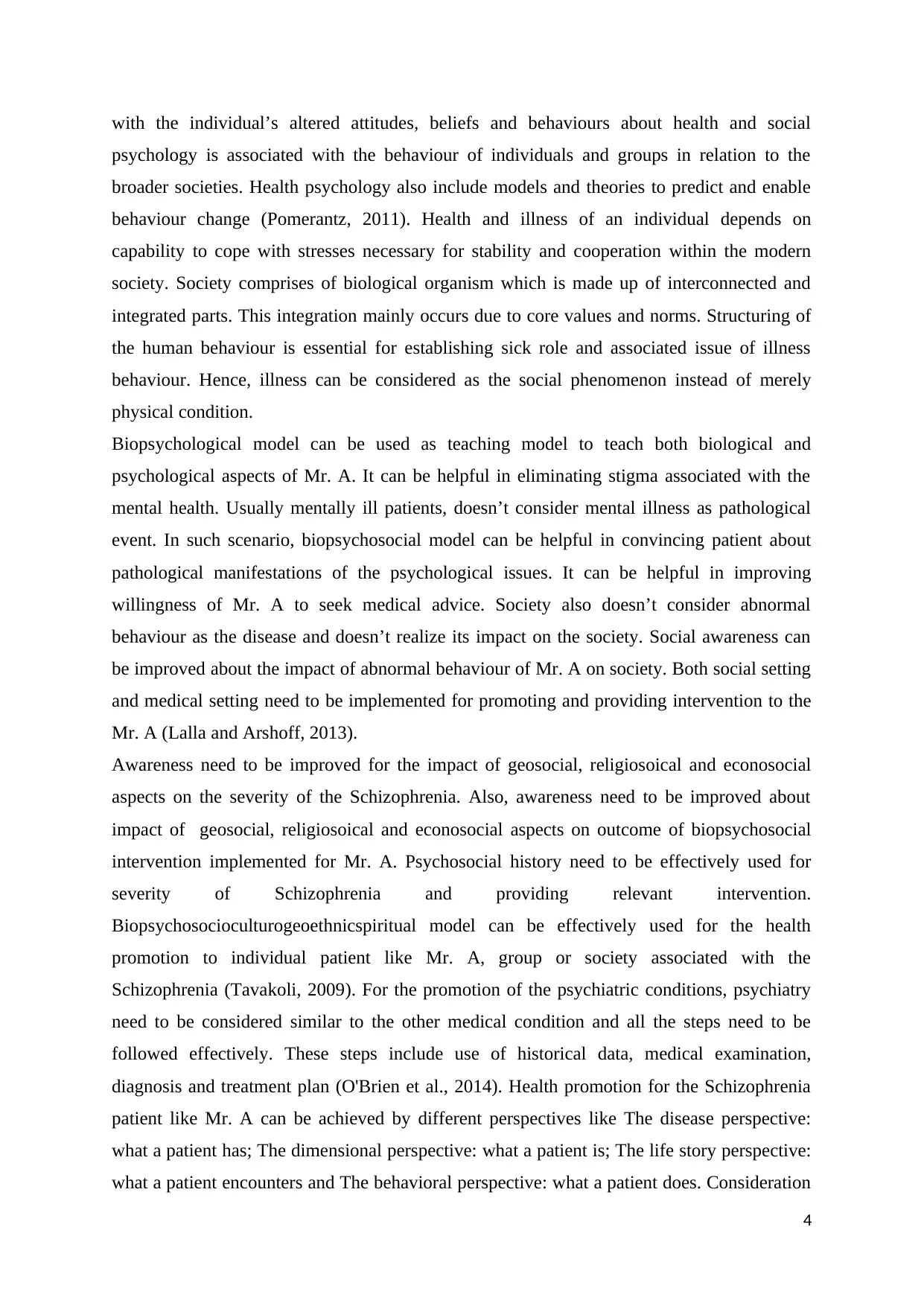
with the individual’s altered attitudes, beliefs and behaviours about health and social
psychology is associated with the behaviour of individuals and groups in relation to the
broader societies. Health psychology also include models and theories to predict and enable
behaviour change (Pomerantz, 2011). Health and illness of an individual depends on
capability to cope with stresses necessary for stability and cooperation within the modern
society. Society comprises of biological organism which is made up of interconnected and
integrated parts. This integration mainly occurs due to core values and norms. Structuring of
the human behaviour is essential for establishing sick role and associated issue of illness
behaviour. Hence, illness can be considered as the social phenomenon instead of merely
physical condition.
Biopsychological model can be used as teaching model to teach both biological and
psychological aspects of Mr. A. It can be helpful in eliminating stigma associated with the
mental health. Usually mentally ill patients, doesn’t consider mental illness as pathological
event. In such scenario, biopsychosocial model can be helpful in convincing patient about
pathological manifestations of the psychological issues. It can be helpful in improving
willingness of Mr. A to seek medical advice. Society also doesn’t consider abnormal
behaviour as the disease and doesn’t realize its impact on the society. Social awareness can
be improved about the impact of abnormal behaviour of Mr. A on society. Both social setting
and medical setting need to be implemented for promoting and providing intervention to the
Mr. A (Lalla and Arshoff, 2013).
Awareness need to be improved for the impact of geosocial, religiosoical and econosocial
aspects on the severity of the Schizophrenia. Also, awareness need to be improved about
impact of geosocial, religiosoical and econosocial aspects on outcome of biopsychosocial
intervention implemented for Mr. A. Psychosocial history need to be effectively used for
severity of Schizophrenia and providing relevant intervention.
Biopsychosocioculturogeoethnicspiritual model can be effectively used for the health
promotion to individual patient like Mr. A, group or society associated with the
Schizophrenia (Tavakoli, 2009). For the promotion of the psychiatric conditions, psychiatry
need to be considered similar to the other medical condition and all the steps need to be
followed effectively. These steps include use of historical data, medical examination,
diagnosis and treatment plan (O'Brien et al., 2014). Health promotion for the Schizophrenia
patient like Mr. A can be achieved by different perspectives like The disease perspective:
what a patient has; The dimensional perspective: what a patient is; The life story perspective:
what a patient encounters and The behavioral perspective: what a patient does. Consideration
4
psychology is associated with the behaviour of individuals and groups in relation to the
broader societies. Health psychology also include models and theories to predict and enable
behaviour change (Pomerantz, 2011). Health and illness of an individual depends on
capability to cope with stresses necessary for stability and cooperation within the modern
society. Society comprises of biological organism which is made up of interconnected and
integrated parts. This integration mainly occurs due to core values and norms. Structuring of
the human behaviour is essential for establishing sick role and associated issue of illness
behaviour. Hence, illness can be considered as the social phenomenon instead of merely
physical condition.
Biopsychological model can be used as teaching model to teach both biological and
psychological aspects of Mr. A. It can be helpful in eliminating stigma associated with the
mental health. Usually mentally ill patients, doesn’t consider mental illness as pathological
event. In such scenario, biopsychosocial model can be helpful in convincing patient about
pathological manifestations of the psychological issues. It can be helpful in improving
willingness of Mr. A to seek medical advice. Society also doesn’t consider abnormal
behaviour as the disease and doesn’t realize its impact on the society. Social awareness can
be improved about the impact of abnormal behaviour of Mr. A on society. Both social setting
and medical setting need to be implemented for promoting and providing intervention to the
Mr. A (Lalla and Arshoff, 2013).
Awareness need to be improved for the impact of geosocial, religiosoical and econosocial
aspects on the severity of the Schizophrenia. Also, awareness need to be improved about
impact of geosocial, religiosoical and econosocial aspects on outcome of biopsychosocial
intervention implemented for Mr. A. Psychosocial history need to be effectively used for
severity of Schizophrenia and providing relevant intervention.
Biopsychosocioculturogeoethnicspiritual model can be effectively used for the health
promotion to individual patient like Mr. A, group or society associated with the
Schizophrenia (Tavakoli, 2009). For the promotion of the psychiatric conditions, psychiatry
need to be considered similar to the other medical condition and all the steps need to be
followed effectively. These steps include use of historical data, medical examination,
diagnosis and treatment plan (O'Brien et al., 2014). Health promotion for the Schizophrenia
patient like Mr. A can be achieved by different perspectives like The disease perspective:
what a patient has; The dimensional perspective: what a patient is; The life story perspective:
what a patient encounters and The behavioral perspective: what a patient does. Consideration
4
Secure Best Marks with AI Grader
Need help grading? Try our AI Grader for instant feedback on your assignments.

of these different perspectives is important because these perspectives changes for each
patient. Schizophrenia patients, their family members and society members need to learn
about the schizophrenia, coping with symptoms of schizophrenia, and communication and
social relationships. Health education programme for Mr. A and family members need to be
developed based on different aspects like degree of family relationship, educational level and
income level. Physical health need to be promoted in Mr. A to prevent other complications
like cardiometabolic risk factors. Counselling need to be given to the Mr. A to avoid
development of stigma related to mental illness. Advice regarding medication consumption
need to be given Schizophrenic patient because most of the anti-psychotic drugs are
associated with the adverse drug events (Smeerdijk et al., 2015; Smeerdijk et al., 2014).
From the research, it is evident that prevalence of mental illness is higher in physically ill
patients and vice versa. In indicate, there is strong interaction between physical and
psychological aspects. In recent times, there is increase in the gap between people with
mental and physical illness and people without illness. Absence of either physical,
psychological or both illness can improve overall health and wellbeing of the Schizophrenia
patient (Soundy et al., 2014). Interaction between the physical and psychological health
depends on the relationship between the lifestyle choices and social interaction. Unhealthy
lifestyle can lead to stress which can adversely affect physiology and physical health. In turn,
it leads to social isolation and it adversely affects overall wellbeing of the Schizophrenia
patient. Physical activity and physical health are most important aspects for psychological
health and its most prominent effect is evident in patients with older age. Even though, there
is strong link between the physical and psychological health, specific pathways were not
being established between physical and psychological. Hence, more research need to be
carried out to establish pathway directed relationship between the physical and psychological
health (Rastad et al., 2014).
Assessment of physical and psychological health need to be carried out simultaneously.
Physical health can be assessed using activities of daily living (ADL) and psychological
health can be assessed using depression and behavioural scale. Simultaneous assessment can
be helpful in the assessing interaction between physical and psychological health. Social
interaction can have positive effect on both physical and psychological health of the patient.
Social interaction can establish positive social ties, good health behaviours and good life
experiences. It is evident that, people with mental illness were less likely to receive
intervention for physical illness and vice versa. Hence, either conditions can exaggerate due
to improper assessment and diagnosis of Mr. A. Lifestyle factors like exercise, smoking and
5
patient. Schizophrenia patients, their family members and society members need to learn
about the schizophrenia, coping with symptoms of schizophrenia, and communication and
social relationships. Health education programme for Mr. A and family members need to be
developed based on different aspects like degree of family relationship, educational level and
income level. Physical health need to be promoted in Mr. A to prevent other complications
like cardiometabolic risk factors. Counselling need to be given to the Mr. A to avoid
development of stigma related to mental illness. Advice regarding medication consumption
need to be given Schizophrenic patient because most of the anti-psychotic drugs are
associated with the adverse drug events (Smeerdijk et al., 2015; Smeerdijk et al., 2014).
From the research, it is evident that prevalence of mental illness is higher in physically ill
patients and vice versa. In indicate, there is strong interaction between physical and
psychological aspects. In recent times, there is increase in the gap between people with
mental and physical illness and people without illness. Absence of either physical,
psychological or both illness can improve overall health and wellbeing of the Schizophrenia
patient (Soundy et al., 2014). Interaction between the physical and psychological health
depends on the relationship between the lifestyle choices and social interaction. Unhealthy
lifestyle can lead to stress which can adversely affect physiology and physical health. In turn,
it leads to social isolation and it adversely affects overall wellbeing of the Schizophrenia
patient. Physical activity and physical health are most important aspects for psychological
health and its most prominent effect is evident in patients with older age. Even though, there
is strong link between the physical and psychological health, specific pathways were not
being established between physical and psychological. Hence, more research need to be
carried out to establish pathway directed relationship between the physical and psychological
health (Rastad et al., 2014).
Assessment of physical and psychological health need to be carried out simultaneously.
Physical health can be assessed using activities of daily living (ADL) and psychological
health can be assessed using depression and behavioural scale. Simultaneous assessment can
be helpful in the assessing interaction between physical and psychological health. Social
interaction can have positive effect on both physical and psychological health of the patient.
Social interaction can establish positive social ties, good health behaviours and good life
experiences. It is evident that, people with mental illness were less likely to receive
intervention for physical illness and vice versa. Hence, either conditions can exaggerate due
to improper assessment and diagnosis of Mr. A. Lifestyle factors like exercise, smoking and
5
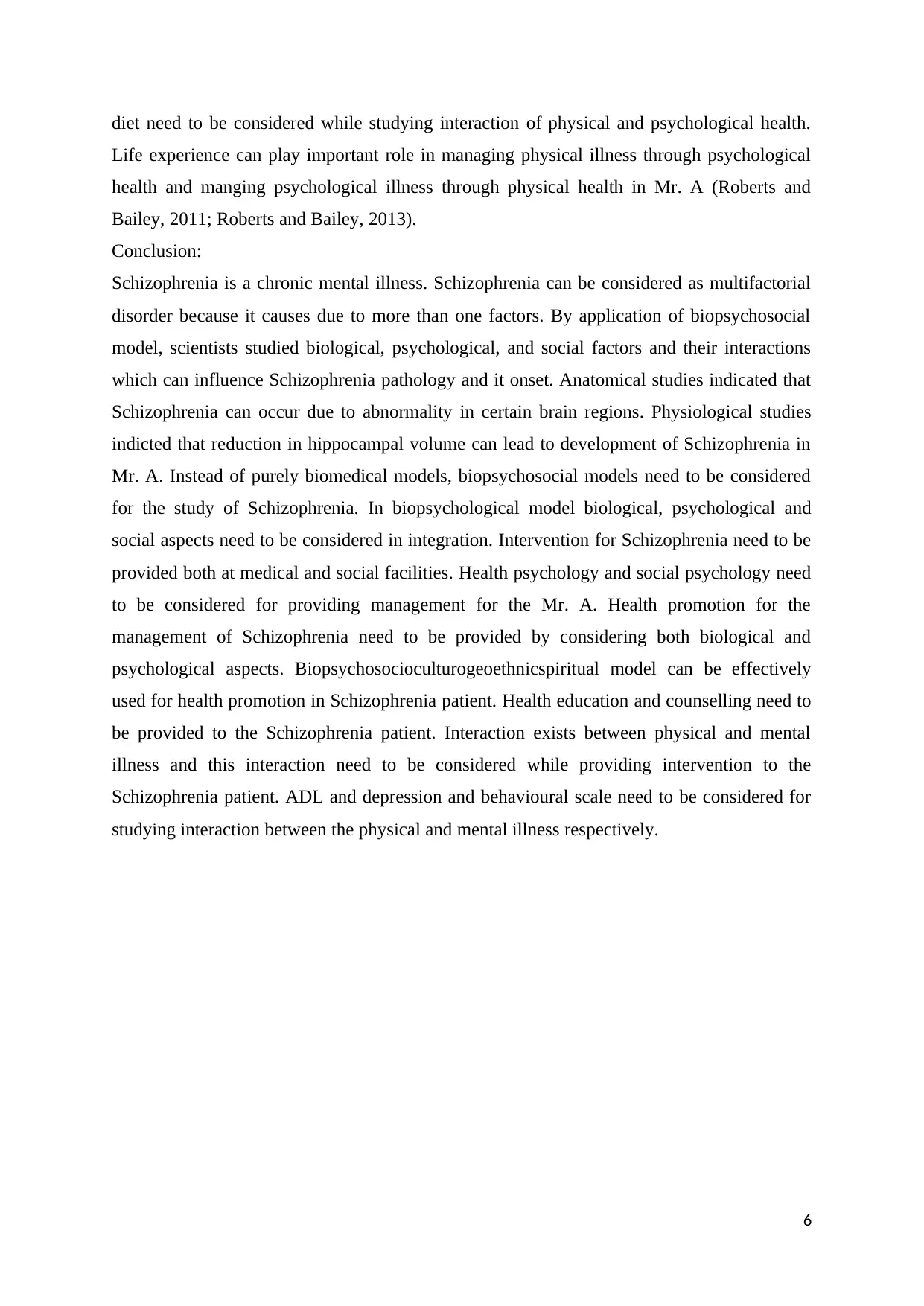
diet need to be considered while studying interaction of physical and psychological health.
Life experience can play important role in managing physical illness through psychological
health and manging psychological illness through physical health in Mr. A (Roberts and
Bailey, 2011; Roberts and Bailey, 2013).
Conclusion:
Schizophrenia is a chronic mental illness. Schizophrenia can be considered as multifactorial
disorder because it causes due to more than one factors. By application of biopsychosocial
model, scientists studied biological, psychological, and social factors and their interactions
which can influence Schizophrenia pathology and it onset. Anatomical studies indicated that
Schizophrenia can occur due to abnormality in certain brain regions. Physiological studies
indicted that reduction in hippocampal volume can lead to development of Schizophrenia in
Mr. A. Instead of purely biomedical models, biopsychosocial models need to be considered
for the study of Schizophrenia. In biopsychological model biological, psychological and
social aspects need to be considered in integration. Intervention for Schizophrenia need to be
provided both at medical and social facilities. Health psychology and social psychology need
to be considered for providing management for the Mr. A. Health promotion for the
management of Schizophrenia need to be provided by considering both biological and
psychological aspects. Biopsychosocioculturogeoethnicspiritual model can be effectively
used for health promotion in Schizophrenia patient. Health education and counselling need to
be provided to the Schizophrenia patient. Interaction exists between physical and mental
illness and this interaction need to be considered while providing intervention to the
Schizophrenia patient. ADL and depression and behavioural scale need to be considered for
studying interaction between the physical and mental illness respectively.
6
Life experience can play important role in managing physical illness through psychological
health and manging psychological illness through physical health in Mr. A (Roberts and
Bailey, 2011; Roberts and Bailey, 2013).
Conclusion:
Schizophrenia is a chronic mental illness. Schizophrenia can be considered as multifactorial
disorder because it causes due to more than one factors. By application of biopsychosocial
model, scientists studied biological, psychological, and social factors and their interactions
which can influence Schizophrenia pathology and it onset. Anatomical studies indicated that
Schizophrenia can occur due to abnormality in certain brain regions. Physiological studies
indicted that reduction in hippocampal volume can lead to development of Schizophrenia in
Mr. A. Instead of purely biomedical models, biopsychosocial models need to be considered
for the study of Schizophrenia. In biopsychological model biological, psychological and
social aspects need to be considered in integration. Intervention for Schizophrenia need to be
provided both at medical and social facilities. Health psychology and social psychology need
to be considered for providing management for the Mr. A. Health promotion for the
management of Schizophrenia need to be provided by considering both biological and
psychological aspects. Biopsychosocioculturogeoethnicspiritual model can be effectively
used for health promotion in Schizophrenia patient. Health education and counselling need to
be provided to the Schizophrenia patient. Interaction exists between physical and mental
illness and this interaction need to be considered while providing intervention to the
Schizophrenia patient. ADL and depression and behavioural scale need to be considered for
studying interaction between the physical and mental illness respectively.
6
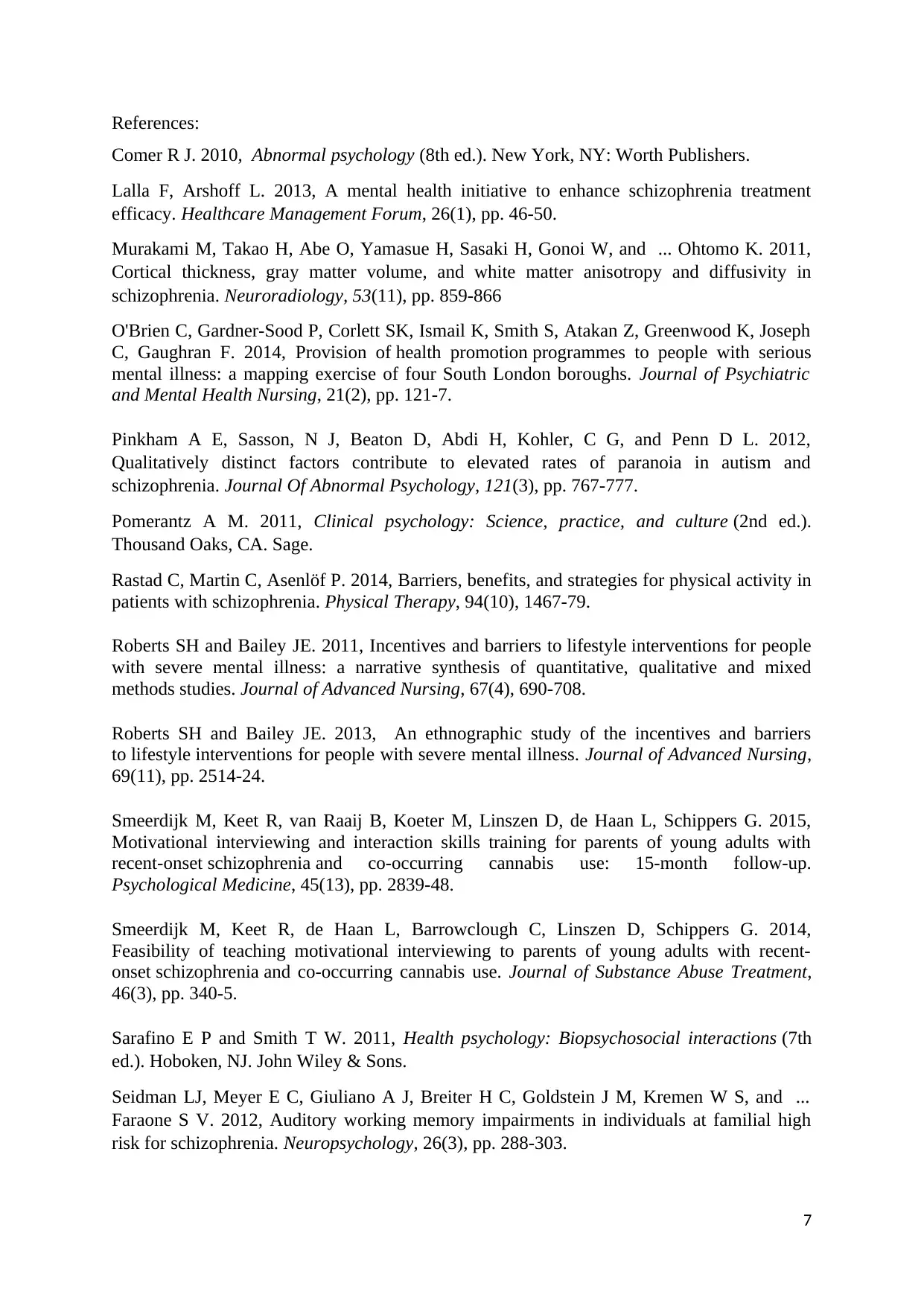
References:
Comer R J. 2010, Abnormal psychology (8th ed.). New York, NY: Worth Publishers.
Lalla F, Arshoff L. 2013, A mental health initiative to enhance schizophrenia treatment
efficacy. Healthcare Management Forum, 26(1), pp. 46-50.
Murakami M, Takao H, Abe O, Yamasue H, Sasaki H, Gonoi W, and ... Ohtomo K. 2011,
Cortical thickness, gray matter volume, and white matter anisotropy and diffusivity in
schizophrenia. Neuroradiology, 53(11), pp. 859-866
O'Brien C, Gardner-Sood P, Corlett SK, Ismail K, Smith S, Atakan Z, Greenwood K, Joseph
C, Gaughran F. 2014, Provision of health promotion programmes to people with serious
mental illness: a mapping exercise of four South London boroughs. Journal of Psychiatric
and Mental Health Nursing, 21(2), pp. 121-7.
Pinkham A E, Sasson, N J, Beaton D, Abdi H, Kohler, C G, and Penn D L. 2012,
Qualitatively distinct factors contribute to elevated rates of paranoia in autism and
schizophrenia. Journal Of Abnormal Psychology, 121(3), pp. 767-777.
Pomerantz A M. 2011, Clinical psychology: Science, practice, and culture (2nd ed.).
Thousand Oaks, CA. Sage.
Rastad C, Martin C, Asenlöf P. 2014, Barriers, benefits, and strategies for physical activity in
patients with schizophrenia. Physical Therapy, 94(10), 1467-79.
Roberts SH and Bailey JE. 2011, Incentives and barriers to lifestyle interventions for people
with severe mental illness: a narrative synthesis of quantitative, qualitative and mixed
methods studies. Journal of Advanced Nursing, 67(4), 690-708.
Roberts SH and Bailey JE. 2013, An ethnographic study of the incentives and barriers
to lifestyle interventions for people with severe mental illness. Journal of Advanced Nursing,
69(11), pp. 2514-24.
Smeerdijk M, Keet R, van Raaij B, Koeter M, Linszen D, de Haan L, Schippers G. 2015,
Motivational interviewing and interaction skills training for parents of young adults with
recent-onset schizophrenia and co-occurring cannabis use: 15-month follow-up.
Psychological Medicine, 45(13), pp. 2839-48.
Smeerdijk M, Keet R, de Haan L, Barrowclough C, Linszen D, Schippers G. 2014,
Feasibility of teaching motivational interviewing to parents of young adults with recent-
onset schizophrenia and co-occurring cannabis use. Journal of Substance Abuse Treatment,
46(3), pp. 340-5.
Sarafino E P and Smith T W. 2011, Health psychology: Biopsychosocial interactions (7th
ed.). Hoboken, NJ. John Wiley & Sons.
Seidman LJ, Meyer E C, Giuliano A J, Breiter H C, Goldstein J M, Kremen W S, and ...
Faraone S V. 2012, Auditory working memory impairments in individuals at familial high
risk for schizophrenia. Neuropsychology, 26(3), pp. 288-303.
7
Comer R J. 2010, Abnormal psychology (8th ed.). New York, NY: Worth Publishers.
Lalla F, Arshoff L. 2013, A mental health initiative to enhance schizophrenia treatment
efficacy. Healthcare Management Forum, 26(1), pp. 46-50.
Murakami M, Takao H, Abe O, Yamasue H, Sasaki H, Gonoi W, and ... Ohtomo K. 2011,
Cortical thickness, gray matter volume, and white matter anisotropy and diffusivity in
schizophrenia. Neuroradiology, 53(11), pp. 859-866
O'Brien C, Gardner-Sood P, Corlett SK, Ismail K, Smith S, Atakan Z, Greenwood K, Joseph
C, Gaughran F. 2014, Provision of health promotion programmes to people with serious
mental illness: a mapping exercise of four South London boroughs. Journal of Psychiatric
and Mental Health Nursing, 21(2), pp. 121-7.
Pinkham A E, Sasson, N J, Beaton D, Abdi H, Kohler, C G, and Penn D L. 2012,
Qualitatively distinct factors contribute to elevated rates of paranoia in autism and
schizophrenia. Journal Of Abnormal Psychology, 121(3), pp. 767-777.
Pomerantz A M. 2011, Clinical psychology: Science, practice, and culture (2nd ed.).
Thousand Oaks, CA. Sage.
Rastad C, Martin C, Asenlöf P. 2014, Barriers, benefits, and strategies for physical activity in
patients with schizophrenia. Physical Therapy, 94(10), 1467-79.
Roberts SH and Bailey JE. 2011, Incentives and barriers to lifestyle interventions for people
with severe mental illness: a narrative synthesis of quantitative, qualitative and mixed
methods studies. Journal of Advanced Nursing, 67(4), 690-708.
Roberts SH and Bailey JE. 2013, An ethnographic study of the incentives and barriers
to lifestyle interventions for people with severe mental illness. Journal of Advanced Nursing,
69(11), pp. 2514-24.
Smeerdijk M, Keet R, van Raaij B, Koeter M, Linszen D, de Haan L, Schippers G. 2015,
Motivational interviewing and interaction skills training for parents of young adults with
recent-onset schizophrenia and co-occurring cannabis use: 15-month follow-up.
Psychological Medicine, 45(13), pp. 2839-48.
Smeerdijk M, Keet R, de Haan L, Barrowclough C, Linszen D, Schippers G. 2014,
Feasibility of teaching motivational interviewing to parents of young adults with recent-
onset schizophrenia and co-occurring cannabis use. Journal of Substance Abuse Treatment,
46(3), pp. 340-5.
Sarafino E P and Smith T W. 2011, Health psychology: Biopsychosocial interactions (7th
ed.). Hoboken, NJ. John Wiley & Sons.
Seidman LJ, Meyer E C, Giuliano A J, Breiter H C, Goldstein J M, Kremen W S, and ...
Faraone S V. 2012, Auditory working memory impairments in individuals at familial high
risk for schizophrenia. Neuropsychology, 26(3), pp. 288-303.
7
Paraphrase This Document
Need a fresh take? Get an instant paraphrase of this document with our AI Paraphraser
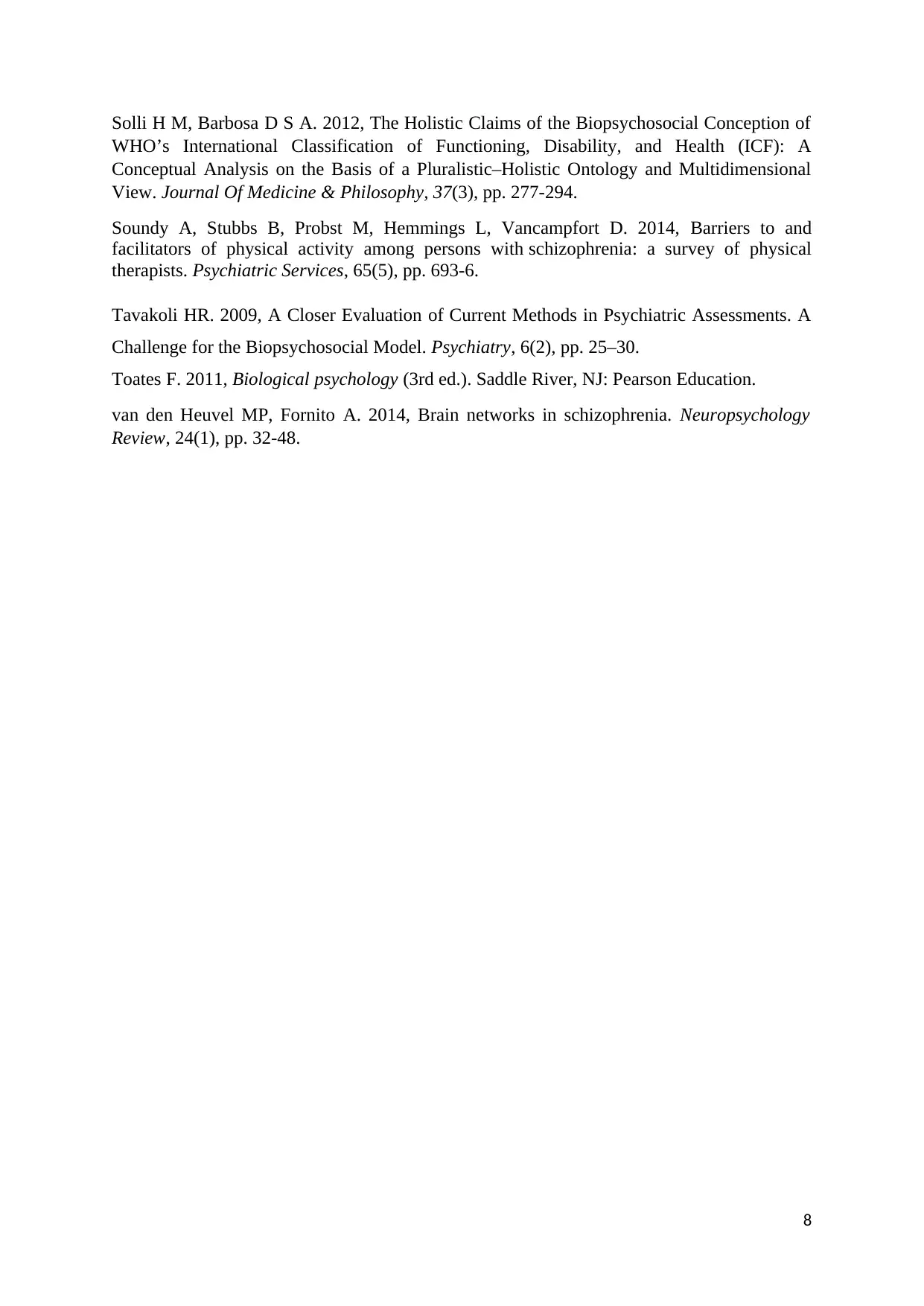
Solli H M, Barbosa D S A. 2012, The Holistic Claims of the Biopsychosocial Conception of
WHO’s International Classification of Functioning, Disability, and Health (ICF): A
Conceptual Analysis on the Basis of a Pluralistic–Holistic Ontology and Multidimensional
View. Journal Of Medicine & Philosophy, 37(3), pp. 277-294.
Soundy A, Stubbs B, Probst M, Hemmings L, Vancampfort D. 2014, Barriers to and
facilitators of physical activity among persons with schizophrenia: a survey of physical
therapists. Psychiatric Services, 65(5), pp. 693-6.
Tavakoli HR. 2009, A Closer Evaluation of Current Methods in Psychiatric Assessments. A
Challenge for the Biopsychosocial Model. Psychiatry, 6(2), pp. 25–30.
Toates F. 2011, Biological psychology (3rd ed.). Saddle River, NJ: Pearson Education.
van den Heuvel MP, Fornito A. 2014, Brain networks in schizophrenia. Neuropsychology
Review, 24(1), pp. 32-48.
8
WHO’s International Classification of Functioning, Disability, and Health (ICF): A
Conceptual Analysis on the Basis of a Pluralistic–Holistic Ontology and Multidimensional
View. Journal Of Medicine & Philosophy, 37(3), pp. 277-294.
Soundy A, Stubbs B, Probst M, Hemmings L, Vancampfort D. 2014, Barriers to and
facilitators of physical activity among persons with schizophrenia: a survey of physical
therapists. Psychiatric Services, 65(5), pp. 693-6.
Tavakoli HR. 2009, A Closer Evaluation of Current Methods in Psychiatric Assessments. A
Challenge for the Biopsychosocial Model. Psychiatry, 6(2), pp. 25–30.
Toates F. 2011, Biological psychology (3rd ed.). Saddle River, NJ: Pearson Education.
van den Heuvel MP, Fornito A. 2014, Brain networks in schizophrenia. Neuropsychology
Review, 24(1), pp. 32-48.
8
1 out of 8
Related Documents
Your All-in-One AI-Powered Toolkit for Academic Success.
+13062052269
info@desklib.com
Available 24*7 on WhatsApp / Email
![[object Object]](/_next/static/media/star-bottom.7253800d.svg)
Unlock your academic potential
© 2024 | Zucol Services PVT LTD | All rights reserved.




